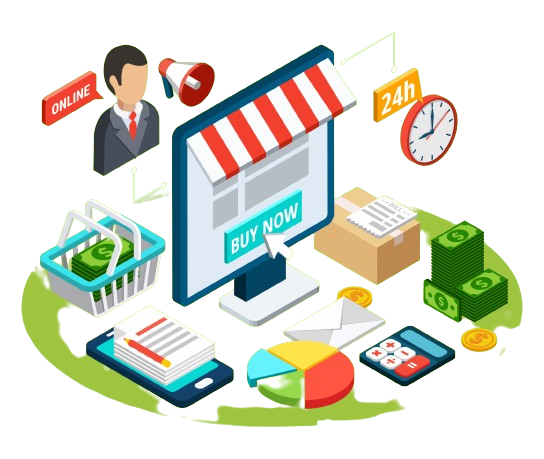
The eCommerce business landscape constantly evolves, with new developments and enterprise fashions shaping how marketers interact with online markets. In 2024, the virtual market is poised for innovation, presenting a diverse range of eCommerce business models. Let’s delve into the ten models that might be expected to dominate in 2024, exploring the particular advantages and demanding situations everyone brings to the desk.
1. Traditional Online Retail
Traditional online retail involves selling products to purchasers at once on an eCommerce website. This model presents groups with management over stock and pricing, leveraging patron trust inside the online purchasing experience.
Key Features
- Direct Sales: Sell merchandise directly to customers.
- Inventory Control: Manage your stock.
- Branding: Establish and preserve your brand identity.
Pros
- Establish Consumer Trust: Traditional online retail blessings from customer familiarity and consideration within the online buying experience.
- Direct Control Over Products and Pricing: Businesses have complete control over their inventory and pricing strategies.
Cons
- Intense Competition: The saturated nature of the market could make it difficult for agencies to stand out.
- Operating Costs May Be Higher: Managing stock and achievement can improve operational costs.
2. Dropshipping
Dropshipping is a low-threat eCommerce business model in which organizations collaborate with providers to fulfill orders. With minimal premature investment, groups can recognize advertising, marketing, and customer engagement even when averting inventory control complexities.
Key Features
- Low Initial Investment: Start with minimal upfront prices.
- Supplier Relationships: Partner with providers for order success.
- Focus on Marketing: Concentrate on advertising and purchaser acquisition.
Pros
- Low Initial Investment: Dropshipping requires minimum premature capital for inventory.
- Minimal Inventory Management: Businesses should not address inventory’s complexities.
Cons
- Lower Profit Margins: Profit margins tend to be lower due to the reliance on 1/3-birthday party providers.
- Limited Control Over Stock and Shipping: Businesses can also face challenges regarding inventory availability and transport instances.
3. Subscription eCommerce
Subscription eCommerce is predicated on ordinary payments to gainer services or products. This model fosters purchaser loyalty via a predictable sales movement and continuous price shipping, though market saturation can pose demanding situations in specific niches.
Key Features
- Recurring Revenue: Generate predictable income through subscriptions.
- Continuous Value: Provide ongoing fees to keep subscribers.
- Customer Loyalty: Build long-term relationships with clients.
Pros
- Predictable Revenue Stream: Subscriptions provide constant and predictable profits.
- Customer Loyalty and Retention: Subscribers are frequently extra loyal, increasing patron lifetime value.
Cons
- Continuous Value Delivery Required: Consistently delivering value is crucial to hold subscribers.
- Market Saturation in Some Niches: Certain subscription niches may emerge as saturated, making it more difficult to face out.
4. Marketplace
Marketplaces join more than one seller with a broad patron base. While imparting exposure, groups face excessive competition and restricted control over branding on those established systems.
Key Features
- Broad Exposure: Reach a vast target market through established systems.
- Customer Trust: Leverage the credibility of well-known marketplaces.
- Competition: Navigate opposition in the marketplace.
Pros
- Access to a Broad Customer Base: Marketplaces provide exposure to an extensive target audience.
- Established Platform Credibility: Businesses benefit from the acceptance as accurately associated with established platforms.
Cons
- High Competition: Standing out amongst several sellers may take much work.
- Limited Control Over Branding: Individual sellers may additionally have constrained manipulation over branding and patron enjoyment.
5. Crowdfunding Platforms
Crowdfunding systems enable businesses to raise funds through pre-selling services or products. This model offers marketplace validation and early purchaser engagement, although fulfillment is not assured, and structures may also have costs and rules.
Key Features
- Fundraising: Raise capital via pre-sales and pledges.
- Market Validation: Validate product calls for inside the marketplace.
- Early Customer Engagement: Engage with customers for the duration of the development segment.
Pros
- Fundraising and Market Validation: Crowdfunding can offer capital and validate the market demand for a product.
- Early Customer Engagement: Engaging with clients early in the product development process.
Cons
- Project Success Not Guaranteed: There’s no guarantee of undertaking achievement, and some tasks can also fail to reach their investment dreams.
- Platform Fees and Regulations: Crowdfunding systems often price costs, and there are regulatory considerations.
6. Social Commerce
Social commerce integrates purchasing capabilities into social media systems, improving discoverability and client engagement. Businesses depend on social media algorithms and can have restrained manipulation over consumer enjoyment.
Key Features
- Seamless Integration: Integrate purchasing into social media structures.
- Enhanced Discoverability: Reach audiences through social media.
- User Engagement: Interact at once with customers on social platforms.
Pros
- Seamless Integration with Social Platforms: Integration with social media complements discoverability.
- Enhanced Customer Engagement: Social commerce allows direct interplay with customers.
Cons
- Dependency on Social Media Algorithms: Changes in algorithms can affect visibility.
- Limited Control Over User Experience: Businesses may additionally have limited control over the user experience of social platforms.
7. Digital Products and Services
Digital eCommerce sells non-physical goods, including e-books, software programs, or online publications. With high-profit margins and scalability, businesses must navigate highbrow assassetcerns and decide to continue.
Key Features
- High-Profit Margins: Earn high profits with minimum manufacturing prices.
- Scalability: Easily scale virtual merchandise to a global target market.
- Continuous Innovation: Stay aggressive through ongoing product development.
Pros
- High-Profit Margins: Once created, virtual merchandise can be bought repeatedly with minimum additional prices.
- Easily Scalable: Digital merchandise is a global target market.
Cons
- Intell without a problem: Sectual Property Concerns: Protecting virtual merchandise from piracy and unauthorized use may be a task.
- Continuous Innovation Required: Staying competitive requires non-stop innovation and updates.
8. B2B eCommerce
Business-to-business enterprise (B2B) eCommerce enables transactions between corporations. Regarding large volumes and long-term relationships, longer sales cycles and customization-demanding situations can be hurdles.
Key Features
- Large Transaction Volumes: Handle giant enterprise transactions.
- Long-Term Relationships: Build lasting partnerships with other groups.
- Customization: Tailor services or products to fulfill particular commercial enterprise wishes.
Pros
- Large Transaction Volumes: B2B transactions regularly contain larger volumes.
- Long-Term Business Relationships: Building lengthy-time period relationships with business customers.
Cons
- Longer Sales Cycles: B2B sales cycles can be longer and more complex.
- Customization Challenges: Meeting precise commercial enterprise requirements poses challenges.
9. Rental and Sharing Economy
The condo and sharing economic system model promotes sustainable intake by permitting users to get admission to merchandise without possession. While environmentally pleasant, agencies must manipulate logistics and serve and address the restrained marketplace for positive items.
Key Features
- Sustainability: Promote green intake.
- Access Over Ownership: Provide entry to merchandise without ownership.
- Logistics Management: Handle the logistics of condo items.
Pros
- Sustainable and Eco-Friendly: Promoting a sharing economic system contributes to sustainability.
- Access Over Ownership: Customers can access merchandise without the burden of possession.
Cons
- Logistics and Maintenance: Managing the logistics of condominium objects and ensuring upkeep.
- Limited Market for Certain Products: Not all products suit a condo or sharing version.
10. Personalization and Customization
Personalization and customization eCommerce buisiness gives particular, tailored merchandise. With the capability for premium pricing, companies must navigate production complexities and spend money on advertising to attract customers in search of customized studies.
Key Features
- Unique Customer Experience: Provide one-of-a-type products.
- Premium Pricing: Charge better fees for personalized objects.
- Marketing Investment: Invest in marketing to attract a gap target audience.
Pros
- Unique Customer Experience: Offering personalized products creates an individual purchaser revel in.
- Premium Pricing Potential: Customized merchandise often commands higher fees.
Cons
- Production Complexities: Creating personalized gadgets may also involve more complicated manufacturing tactics.
- Higher Customer Acquisition Costs: Attracting clients for personalized products may require higher advertising investments.
Conclusion
The eCommerce business panorama in 2024 gives a diverse array of business models, every with its precise set of advantages and demanding situations. Successful entrepreneurs will want to examine their products, and target market carefully, and enterprises desire to select the version that aligns first-class with their imagination and prescient for the boom.
The potential to adapt to evolving customer developments and technological advancements may be vital to thriving in the dynamic world of eCommerce. As we move forward, it’s clear that innovation and versatility will continue to shape the destiny of online trade.
Please Read Our Latest Blog: Diversity within the Workplace: Meaning, Types, and Benefits




Leave a Comment